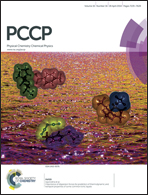A shock tube laser schlieren study of methyl acetate dissociation in the fall-off regime†
Abstract
The pyrolysis of methyl acetate, 2% and 4% dilute in krypton, was investigated in a diaphragmless shock tube (DFST) using laser schlieren densitometry (LS). Experiments were performed at 122 ± 3 and 63 ± 2 Torr over the temperature range of 1492–2266 K. Master equation models for the four main dissociation paths of methyl acetate based on a prior study by Peukert et al. [S. Peukert, R. Sivaramakrishnan, M. Su and J. Michael, Combust. Flame, 2012, 159, 2312–2323] were refined and formed the basis for simulating the LS experiments. The density gradient profiles from the LS experiments indicate that the initial dissociation proceeds predominantly by breakage of the C–O bond leading ultimately to two methyl radicals and CO2, accounting for 83–88% of the methyl acetate loss over this temperature range. Rate coefficients for dissociation of methyl acetate were satisfactorily simulated with a master equation model, with modelled rate coefficients of k120 Torr = 9.06 × 1081 × T−19.07 × exp(−61 600K/T) s−1, k60 Torr = 3.71 × 1082 × T−19.34 × exp(−61 200K/T) s−1, and of k∞ = 1.97 × 1030 × T−3.80 × exp(−47 900K/T) s−1 for the major channel, based on fitting to 120 Torr and 60 Torr data taken in this study. The model also captures the pressure dependency of methyl acetate dissociation and resolves an earlier discrepancy concerning the mechanism of dissociation of methyl acetate.


 Please wait while we load your content...
Please wait while we load your content...